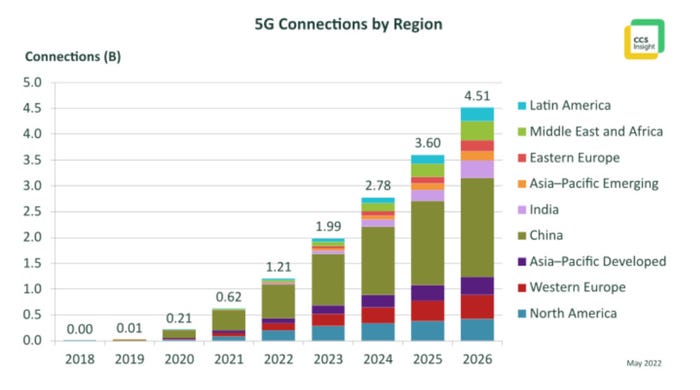5G market expected to cope well with tough economic times
A difficult economic and political situation across the world is suppressing the mobile phone market, but the 5G sector is still coming up smelling of roses.
June 15, 2022

A difficult economic and political situation across the world is suppressing the mobile phone market, but the 5G sector is still coming up smelling of roses.
5G connections globally should reach 1.21 billion by the end of this year, well ahead of the 620 million figure from end-2021, according to new research from CCS Insight. The Covid-19 pandemic had a big impact on the technology’s early years, the analyst firm notes, but things are really starting to pick up now, despite ongoing troubles in much of the world.
There are now more 5G-capable smartphones out there and operators are taking the bull by the horns, rolling out networks and services that were delayed as a result of the pandemic. Well-documented supply chain issues are still a consideration, but manufacturers – chip makers and device makers – are essentially prioritising the higher-end 5G market where there is still strong consumer demand.
Demand is not quite so strong across the board. CCS Insight expects 2022 to be “a weak year” for the overall mobile phone market, due both to supply chain problems and declining demand from end users, many of whom are keeping a close eye on the purse strings at present.
“The world still faces a bleak macroeconomic and geopolitical outlook in 2022, coupled with supply chain difficulties. But the transition of mobile subscribers to 5G networks is set to make good progress, with 5G connections forecast to nearly double this year to 1.2 billion,” said James Manning Smith, senior analyst at CCS Insight, in a statement accompanying the figures.
5G connectivity is now a standard feature of premium smartphones and is pushing strongly into the mid-tier, the analyst said. “With 681 million new phones – 44% of all mobile phone sales in 2022 – expected to have 5G connectivity, a strong base of 5G-ready mobile phones is developing.”
While mobile broadband usage on phones, tablets, laptops and the like will account for 99% of 5G connections this year, there are also other emerging areas of growth for the technology, namely fixed wireless access and Internet of Things (IoT). The analyst firm puts 5G IoT connections at 9 million by the end of this year and as many as 455 million by 2026.
It predicts 5G fixed wireless connections will grow 160% this year to 7 million globally, rising further to 83 million by 2026. That might currently seem like a drop in the ocean, but it demonstrates some momentum in a market that has for years been restricted largely to people who have no other alternative for home broadband.
“Competition in the fixed wireless segment is heating up, particularly in North America,” said Manning Smith. “T-Mobile, Verizon and AT&T are treating 5G fixed wireless access as an integral part of their 5G strategies and this is already bearing fruit, with T-Mobile reporting over 1 million customers.”
Indeed, T-Mobile US in particular is pushing hard on FWA. The operator last month launched a new 5G-based fixed wireless service for consumers, accompanied by a big marketing push encouraging potential customers to cut ties with their fixed broadband providers. It also added a new FWA offer and new kit for its business customers, and later unveiled a broader 5G enterprise strategy that will help it monetise its 5G network.
China, North America and Western Europe will help boost global 5G mobile broadband connections to 4 billion by 2026, which represents 45% of the global mobile broadband total, according to CCS Insight’s figures. However, the company notes that markets like India, the Middle East and Africa will continue to lag, pointing out that there is “a long road ahead” for the developing world when it comes to broad 5G coverage.
That’s not a surprising prediction, when you consider that India, for example, has been dragging its heels on the auction of 5G spectrum. That said, on Wednesday the Indian government finally approved the sale, which it says will take place before the end of July. But the country will have to really get its skates on if it is to have an impact on global 5G uptake figures.

Get the latest news straight to your inbox. Register for the Telecoms.com newsletter here.
About the Author(s)
You May Also Like











_1.jpg?width=700&auto=webp&quality=80&disable=upscale)


.png?width=800&auto=webp&quality=80&disable=upscale)